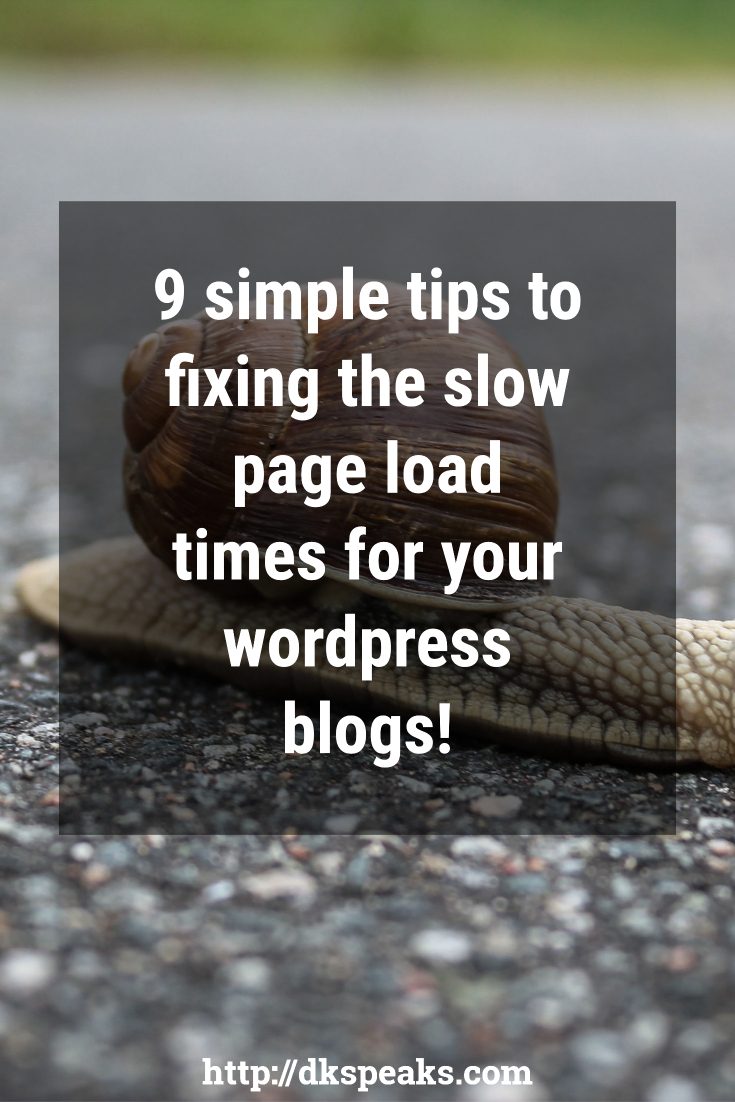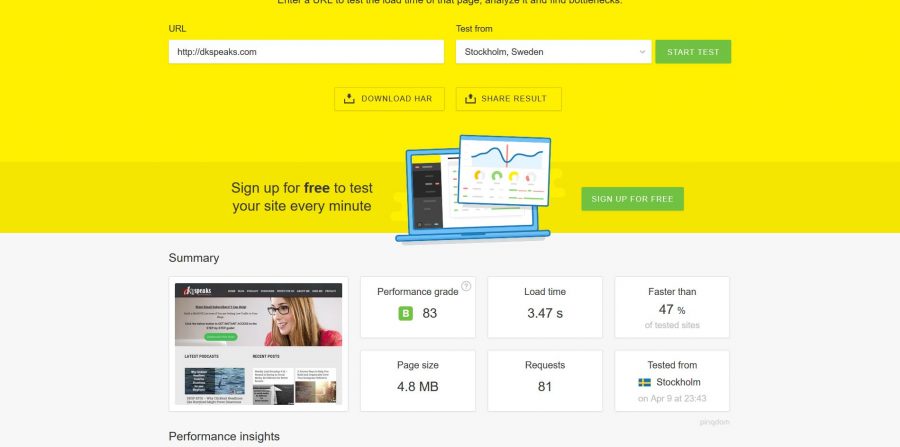Podcast: Play in new window | Download (Duration: 16:58 — 19.8MB) | Embed
Subscribe: Apple Podcasts | Email | TuneIn | RSS

How does page load times affect your websites?
The other day I was searching for a specific recipe that I had bookmarked some time back. I was on my mobile phone and I had to quickly access the recipe blog.
I clicked on the link and waited for the page to open. The wait went on for a few seconds and the page was still loading. Out of desperation, I closed the site and quickly switched to my laptop.
I went to my bookmarks and clicked on the link again. The site started loading. After some preliminary stuff had loaded the site was still loading. I waited because I was not able to do anything. My browser was stuck, the page wouldn’t scroll, nothing would click and nothing would move.
Guess what would have been my reaction – Frustration.
And out of frustration I closed the site and searched for other places where I could get hold of that recipe. I even deleted the bookmark because keeping that there was of no use.
Now, this is a situation where I knew about the blog and I was willing to give it a few minutes. Imagine if you are browsing to find something and you stumble upon such a site.
You are seeing the site for the first time.
What will be your reaction?
This is not an uncommon scenario. There are thousands of blogs and websites out there which take ages to load. Wise men say that a user will wait only for about 10 seconds before browsing off.
And if your site takes more than 10 seconds to load, the result is obvious – a lost reader.
So, what do you do about it?
Let us look at 9 Simple ways to speed up your blog’s page load times.
How to Speed up Your Page Load Times
Improving your page load time, is not as difficult as it sounds. There are a few simple tweaks that you can do which can speed up your blog load times considerably.
So you need to first assess your site load speed, which you can do by going to tools.pingdom.com to understand the amount of tweaking you will do.
Check out the below image to see a snapshot for my blog.

Now that you have assessed your site load speed, let us look at some simple tips to improve your site load speeds.
Selecting a Reliable Hosting Provider
Start with your hosting provider and your hosting plan. If you are using a shared host and they run a lot of websites on the same server, then there is no way your site is going to load fast.
Cheap hosting providers often do this and that is one of the primary reasons for a poor loading website.
Ensure that you are hosting your blog with a reliable hosting provider. Bluehost, Hostgator and iPage are some of the best hosting providers as per our experience.
They are reliable and they all provide you with a free CDN which helps in improving the page load times.
Use an Image Compression Plugin
If your blog is an image focussed one, then there is a high possibility that your high quality images are impacting your overall page load times.
Niche blogs in food blogging, fashion blogging etc. where there are a lot of images uploaded to a post, can face this problem.
There are 2 ways to get over it. Firstly, compress the images even before your upload them to your server. You can use a free service like Optimizilla.com to compress the images.
Secondly use an image compression plugin that can help compress all the images that you upload without impacting the overall image quality. I use a plugin called EWWW image optimizer plugin. Its a decent plugin and is available for free at the WordPress plugin directory.
Ad scripts that slow down the site
Contextual video ads are one example of ad scripts that slow down your site. I have seen some of the top blogs that have absolutely ridiculous page loading times and most of them run some of these ads that have huge scripts running behind them, which leads to the slow page load times.
With page load times being in focus so much, it is unlikely that an ad provider hasn’t worked to manage their scripts to facilitate a faster site load time.
But if they haven’t for some reason, then I feel that you should abandon them. It’s a conscious decision that you need to make. It is better to lose some money rather than lose a lot of visitors permanently.
Uninstall plugins you do not use
The biggest advantage of WordPress as a Content Management Solution, is the flexibility it offers with the many plugins that are available to enhance the features of the platform.
At the same time this very thing is also the biggest worry in WordPress. Aside to the fact that these plugins are not managed and maintained by the creators regularly, which can be a security risk, it also drains resources and uses a lot of bandwidth because of the many scripts that run in the background.
There are hundreds of plugins in the WordPress repository and then there are the same number of paid plugins. And because of these many choices, we tend to install plugins that look fancy and does fancy things only to abandon using it after some time.
While plugins can be of great support, it can also drain your server’s resources and slow down your site.
So do a realistic and conscious assessment of your plugins and uninstall the ones that you do not need.
Optimize your database
The entire WordPress blog runs on a few PHP files and a backend databases to support it. These databases can become very heavy over a period of time because of a lot of things. One of it is the codes left behind by the plugins that you uninstalled.
You need to constantly clean your database and optimize it to reduce the size of the database and make it more efficient.
It is recommended that you always keep a backup of your database before you do it.
I recommend using either the WP-Optimize plugin or, WPDBSpringClean which also does the same thing.
Use a Caching plugin
Caching helps keep a static copy of your blog on the server and it loads this copy every-time your blog is requested. This way the use of server resources is minimized because the number of requests are reduced.
Caching is a simple way to decrease page load times and pretty much every managed WordPress hosting provider provides this as part of the package.
The most preferred caching plugin is WP Super Cache and I would recommend using it.
Use pop-up scripts that do not impact your page load times
List building is an integral part of blogging. And your list building efficiency is determined to a great extent by the quality of your popups and landing pages.
There are tons of optin form builders in the market and most of these run a bunch of javascripts in the backend which is called in multiple times as your page loads.
These multiple requests impacts your page load times and delays loading your blog.
Good developers know how it works and they build their plugins while ensuring that the javascripts are combined and minified.
So go with a good optin builder plugin. I recommend Thrive Leads and Thrive Content builder. Thrive Leads has a “Lazy load” option. You can see this option in the below screenshot.

The lazy load option loads the javascripts asynchronously and ensures that these scripts don’t weigh heavy on your blog and doesn’t impact your page load times.
Use a CDN
Using a Content Delivery Network speeds up your page load times. A CDN does a lot of things in the background like, delaying the loading of javascripts, minifying CSS files, caching your pages etc. thus speeding up your website load times.
Cloudflare is a free CDN that you can use on your blogs. You can install their plugin and configure the settings by yourself.
If you are on a competent hosting service provider like Bluehost, you can use Cloudflare on your blogs by just switching it on and off using your cpanel.
If you are looking for a premium CDN, you can use MaxCDN which is a proven Content Delivery Network with excellent support.
Combining and Minifying Your Scripts
CSS files and Javascripts are the main culprit of delayed page load times. And WordPress and its plugins has a ton of javascripts and CSS files running in the background.
The easiest way to speeden up your site is by combining these scripts and CSS file and minifying it. By combining, you can reduce the number of requests that the server makes to these scripts and by minifying it reduces the size of the files.
You can do this by using some simple plugins like Async Javascript and Autoptimize.
These 2 plugins work hand in hand and helps optimize these files thus speedening up your blog.
Summing it all Up
Page load times is one of the critical things that impact customer acquisition. Still a lot of websites ignore this aspect.
While fixing it seems like an overwhelming task, it is not so actually. There are a few low hanging fruits that can immediately fix the page load time issues for your blog.
All it takes is to spend some time doing it.
Resources Mentioned in this Episode
Here are the resources that we mentioned in today’s episode –
- tools.pingdom.com
- Async Javascript
- Autoptimize
- Cloudflare
- MaxCDN
- Thrive Leads
- Thrive Content builder
- WP Super Cache
- WPDBSpringClean
- WP-Optimize
- EWWW image optimizer
- Optimizilla.com
- Bluehost
- Hostgator
- iPage
Thank you for Joining in
Thank you all for joining me today on this episode.
I hope you enjoyed today’s episode. If you did, please do take some time out to rate the show on iTunes and provide us with a genuine review. This helps in the overall ranking of the show and will help people find the show.
You can subscribe to the podcast using any of the below links:
Click here to Subscribe via iTunes

